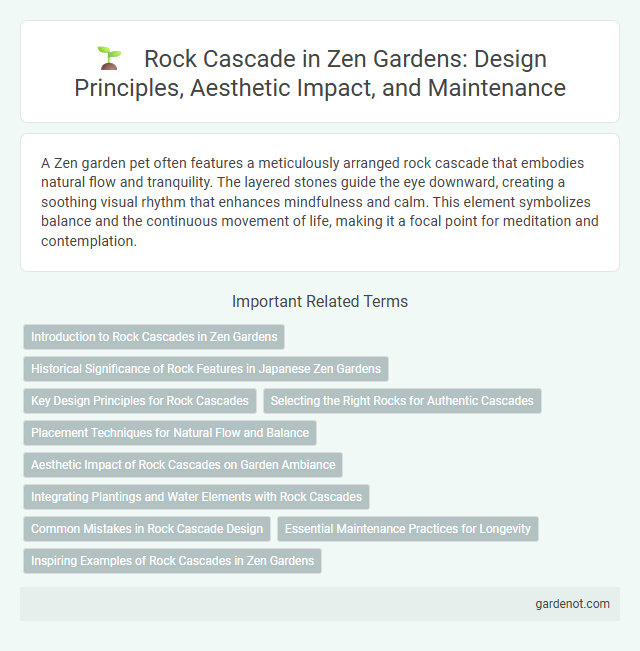A Zen garden pet often features a meticulously arranged rock cascade that embodies natural flow and tranquility. The layered stones guide the eye downward, creating a soothing visual rhythm that enhances mindfulness and calm. This element symbolizes balance and the continuous movement of life, making it a focal point for meditation and contemplation.
Introduction to Rock Cascades in Zen Gardens
Rock cascades in Zen gardens symbolize natural waterfalls and mountain streams, creating a dynamic visual flow using carefully arranged stones of varying sizes. Positioned to mimic the gentle descent of water over rocks, these cascades emphasize balance, movement, and tranquility within the minimalist landscape. The deliberate placement enhances meditation and reflection by evoking the calming sound and rhythm of flowing water without actual moisture.
Historical Significance of Rock Features in Japanese Zen Gardens
Rock cascades in Japanese Zen gardens symbolize natural waterfalls, embodying the principles of simplicity and impermanence central to Zen Buddhism. These carefully arranged stones reflect ancient Japanese aesthetics and spiritual beliefs dating back to the Muromachi period (1336-1573). Their historical significance lies in guiding meditation and invoking a sense of tranquility through the balanced interplay of natural elements.
Key Design Principles for Rock Cascades
Rock cascades in Zen gardens emphasize asymmetry, natural flow, and texture to evoke tranquility and movement. Key design principles include selecting varied rock sizes that mimic natural erosion patterns, arranging stones to guide water flow visually, and integrating moss or lichen to enhance organic appearance. The balance between solidity and fluidity in the cascade fosters a contemplative atmosphere central to Zen aesthetics.
Selecting the Right Rocks for Authentic Cascades
Selecting the right rocks for authentic Zen garden cascades involves choosing stones with natural textures and varied sizes to mimic the flow of water. Smooth river rocks combined with angular stones create a balanced visual contrast that enhances the garden's serene aesthetic. Prioritizing rocks sourced from local quarries ensures geological harmony and sustainability in the garden design.
Placement Techniques for Natural Flow and Balance
Rock cascade placement in Zen gardens requires arranging stones at varying heights and angles to mimic natural water flow, creating visual movement and harmony. Strategically positioning larger rocks at the base and smaller ones ascending simulates cascading water, enhancing the garden's dynamic balance. Incorporating asymmetry and spacing between rocks preserves natural rhythm, fostering a tranquil, balanced atmosphere.
Aesthetic Impact of Rock Cascades on Garden Ambiance
Rock cascades in Zen gardens create a dynamic visual rhythm that enhances the tranquil ambiance, symbolizing the natural flow of water over stones. Their carefully arranged stones provide both texture and depth, fostering a mindful atmosphere conducive to meditation and reflection. The interplay of light and shadow on the rugged surfaces adds a subtle, ever-changing aesthetic that deepens the garden's sensory experience.
Integrating Plantings and Water Elements with Rock Cascades
Rock cascades in Zen gardens harmonize natural stone formations with flowing water to create tranquil, dynamic features that evoke the essence of mountain streams. Integrating plantings such as mosses, ferns, and bamboo around these rock cascades enhances the organic aesthetic, providing textural contrast while maintaining the garden's minimalist design principles. Water elements combined with carefully placed rocks and greenery foster a meditative atmosphere that encourages mindfulness and connection to nature.
Common Mistakes in Rock Cascade Design
Common mistakes in rock cascade design include improper rock placement that disrupts natural water flow and creates stagnant pools. Using uniformly sized rocks rather than varied textures and dimensions can make the cascade look artificial and fail to mimic natural formations. Neglecting to account for drainage and water circulation often leads to erosion and plant damage within the Zen garden landscape.
Essential Maintenance Practices for Longevity
Rock cascades in Zen gardens require regular removal of debris and careful inspection to prevent moss overgrowth, maintaining their natural aesthetic balance. Ensuring proper drainage around the cascade prevents water stagnation, reducing erosion and preserving stone integrity. Periodic realignment of rocks and replenishment of gravel stabilizes the structure, promoting durability and longevity.
Inspiring Examples of Rock Cascades in Zen Gardens
Rock cascades in Zen gardens exemplify the natural flow of mountain streams, creating a soothing ambiance through carefully arranged stones that mimic water movement. Iconic examples include the Ryoan-ji garden in Kyoto, where asymmetrical rock groupings evoke serene waterfalls, and the Daisen-in garden, showcasing cascading rocks symbolizing rivers. These inspiring designs emphasize simplicity, balance, and the harmony between elements, central to Zen principles.
Rock cascade Infographic

 gardenot.com
gardenot.com